Valve Hardware Day 2006 - Multithreaded Edition
by Jarred Walton on November 7, 2006 6:00 AM EST- Posted in
- Trade Shows
Building a Threaded Game Engine
Valve Software researched and experimented with all three multithreading models, and some of the results were promising. The first thing they did was to look at coarse threading, being that it is usually the easiest approach. Like Quake 4 and Call of Duty 2, Valve also has a client-server architecture in the Source engine, so that's where they started. The results can be summarized with the following slide:
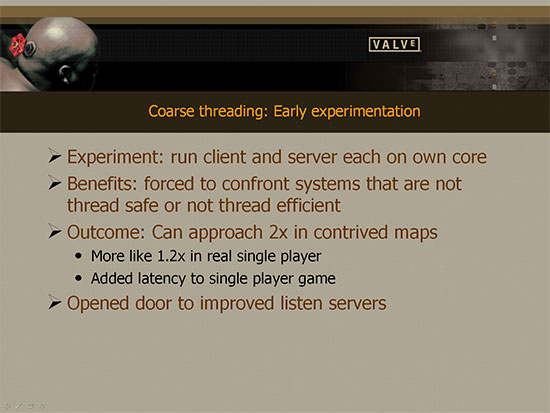
There were benefits to the work that was done, but long-term such an approach is destined to fall short. If you only have a client and a server thread, you are only using two processor cores at most, and even then it is unlikely that you're making full use of both cores. The decision was ultimately reached that the only approach truly worth pursuing as a long-term solution is hybrid threading. It will require the most effort but it will also give the most benefit. As long as you're already rewriting large portions of your engine, the thinking goes, you might as well make sure you do it right so as to avoid doing the same thing again in the near future. The next step is to come up with a threading framework that will allow the developers to accomplish their goals.
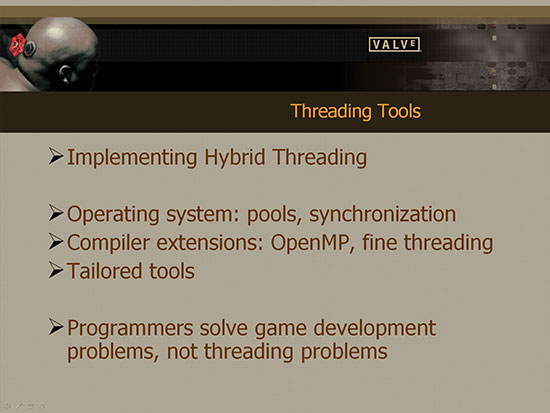
Operating systems and compilers already provide some support for multithreaded programs. In some cases, this support is sufficient, but when it comes to building a real-time gaming engine anything short of a custom threading tool may not provided the desired flexibility. Valve's problems with OS and compiler level threading can be summarized in the following two slides.
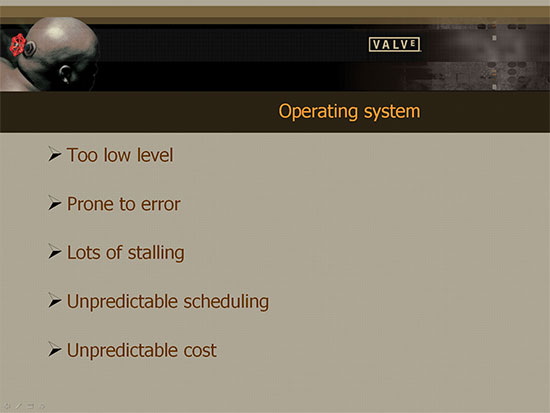
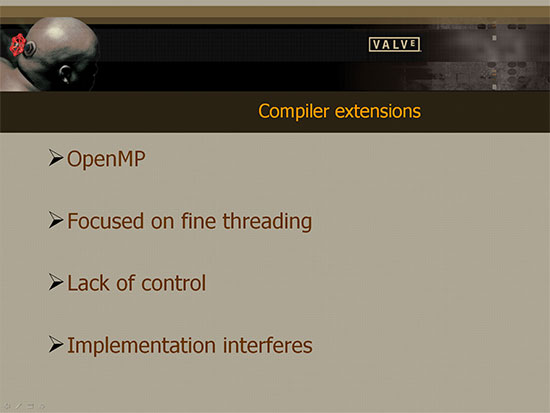
We've already stated several times that making multithreaded programs can be difficult, and the problem is exacerbated when you have many programmers -- some of them junior programmers that have never seen threaded code in their life -- all trying to work together. Valve decided that ultimately what they wanted to create was a threading framework and a set of tools that would allow the programmers and content creators to focus on the important thing, actually creating the games, rather than trying to constantly deal with threading issues. Tom Leonard and a couple other helpers were tasked with creating this toolset, and as you can guess by the existence of this article, their efforts are about to reach fruition.
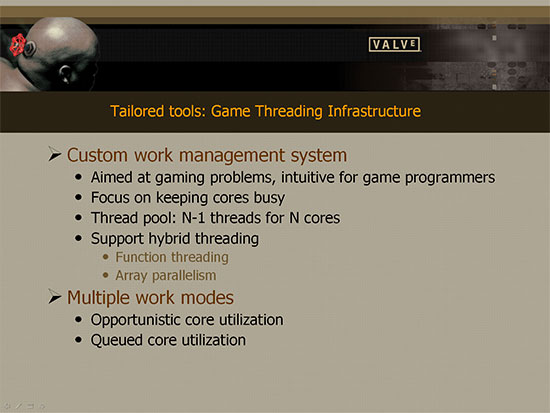
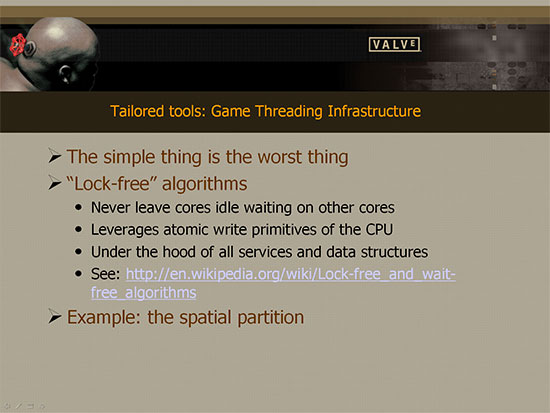
We're not going to try and snowball you with any more information on the low level details at present. Basically, Valve is working hard to provide a toolset that will enable their developers -- as well as mod creators and engine licensees -- to take full advantage of multi-core platforms. They aren't just looking at dual core or even quad core; their goal is to build an engine that is scalable to whatever type of platform users may be running in the future. Of course that doesn't mean they won't be rewriting portions of their engine at some point anyway, but all signs indicate that they should be at the forefront of creating multi-core games and gaming engines.
Valve Software researched and experimented with all three multithreading models, and some of the results were promising. The first thing they did was to look at coarse threading, being that it is usually the easiest approach. Like Quake 4 and Call of Duty 2, Valve also has a client-server architecture in the Source engine, so that's where they started. The results can be summarized with the following slide:

There were benefits to the work that was done, but long-term such an approach is destined to fall short. If you only have a client and a server thread, you are only using two processor cores at most, and even then it is unlikely that you're making full use of both cores. The decision was ultimately reached that the only approach truly worth pursuing as a long-term solution is hybrid threading. It will require the most effort but it will also give the most benefit. As long as you're already rewriting large portions of your engine, the thinking goes, you might as well make sure you do it right so as to avoid doing the same thing again in the near future. The next step is to come up with a threading framework that will allow the developers to accomplish their goals.

Operating systems and compilers already provide some support for multithreaded programs. In some cases, this support is sufficient, but when it comes to building a real-time gaming engine anything short of a custom threading tool may not provided the desired flexibility. Valve's problems with OS and compiler level threading can be summarized in the following two slides.


We've already stated several times that making multithreaded programs can be difficult, and the problem is exacerbated when you have many programmers -- some of them junior programmers that have never seen threaded code in their life -- all trying to work together. Valve decided that ultimately what they wanted to create was a threading framework and a set of tools that would allow the programmers and content creators to focus on the important thing, actually creating the games, rather than trying to constantly deal with threading issues. Tom Leonard and a couple other helpers were tasked with creating this toolset, and as you can guess by the existence of this article, their efforts are about to reach fruition.


We're not going to try and snowball you with any more information on the low level details at present. Basically, Valve is working hard to provide a toolset that will enable their developers -- as well as mod creators and engine licensees -- to take full advantage of multi-core platforms. They aren't just looking at dual core or even quad core; their goal is to build an engine that is scalable to whatever type of platform users may be running in the future. Of course that doesn't mean they won't be rewriting portions of their engine at some point anyway, but all signs indicate that they should be at the forefront of creating multi-core games and gaming engines.










55 Comments
View All Comments
primer - Tuesday, November 7, 2006 - link
it's a nice article. i'm anxious to see what develops out of Valve in the near future.how about using some Athlon FX, Opteron 100/1200 series or higher speed Athlon X2s for crying out loud. i know that here is a performance gap even with the higher AMD models currently, but please show us an attempt at not being as one-sided.
jm20 - Tuesday, November 7, 2006 - link
The tests at 2.0 and 2.4 Ghz for the AMD chips are there, you can plot how it 'should' improve. Here are my scaling projections based on the data given for the 939 platform.AMD Speed single dual
2.0 14.0 27.0
2.2 15.5 29.5
2.4 17.0 32.0
2.6 18.8 35.0
2.8 20.8 38.2
3.0 23.1 41.7
I just hope this will show up correctly :/
Very interesting article, I'm very excited to see an almost linear improvement from single to dual core.
yacoub - Tuesday, November 7, 2006 - link
Your Tested Systems details on page 8 - the last three show a CPU of a Venice 3200+ oc'd to 2.4GHz (hey that's what I run too!), but the headings suggest they should really show Intel chips. :)yacoub - Tuesday, November 7, 2006 - link
Yes please make it only visual and not actually a part of the game, because much like trying too hard to make graphics look realistic, it really just adds more frustration for the player than anything else. It's already annoying in HL2 getting caught up on the edge of prop_physics related objects. The last thing we need is also getting caught or bumped by another player ;)
JarredWalton - Tuesday, November 7, 2006 - link
If the world is more interactive, there might not actually be a need for "prop physics" objects. There's also the potential to make a game with different gameplay mechanics depending on how the character interacts with the world. It sounds like initially Valve will make it a visual enhancement, to make entities look more lifelike in their behavior, but down the road others could potentially do more. Like most of the enhancements, what we want to see is how they can actually change and improve gameplay beyond just being visual.yacoub - Tuesday, November 7, 2006 - link
"You're doing a disservice to the customer if you're not using all of the CPU power."okay so that alone shows the need for dual-core so the customer can offload background tasks to a second core so the game can truly get 100% of a core. ;)
timmiser - Tuesday, November 7, 2006 - link
Background tasks?? I agree with Gabe that I want all of my CPU working the game. I'm sitting here with an Athlon X2 4800+ and I can't run Flight Sim X at an acceptable frame rate all the while I watch the graph that shows CPU#2 at idle while CPU#1 tries to run the entire program by itself!On another note, how about Microsoft develope some type of new API (DirecThread?) that automatically takes care of utilizing multiple cores so that game companies like Valve don't have to employ entire multi-threaded R&D divisions just so their games use both cores.
It seems like we are going back to the caveman days before DirectInput, DirectSound, & DirectX etc. Remember when you had to choose your sound card, joystick, and video card from a list within the game?? Let's not go there again!!
-Tim
JarredWalton - Tuesday, November 7, 2006 - link
That was a direct quote from... Gabe I think. Others might disagree, but I thought it was an interesting take on things. As for background tasks, they usually only need a bit of CPU time (less than 5% in most cases), so unless you really want to encode videos and play games at the same time....yacoub - Tuesday, November 7, 2006 - link
What a worthless attempt at sarcasm:Why not just say something normal like:
It's not omg-witty, but at least that sentence doesn't end with a preposition. @___@
JarredWalton - Tuesday, November 7, 2006 - link
Which obviously ruined the whole article. Seriously yacoub, a little tact with posting would be nice. Rather than stating:You could have just said something normal like:
We are real people, and derogatory adjectives like "worthless" tend to irritate more than help. You may not intend it that way, but imagine for a second someone talking about what you worked on for a couple days last week and describing it as "absolute garbage". The key word in "constructive criticism" is to actually make it constructive.
Now, thanks for the suggestion, and I'm more than happy to change things a bit to appeas people. Like most people, I just appreciate a bit more consideration, even if I'm just doing my job here. :) As the old cliche goes, you can catch more flies with honey than with vinegar. (Well, my grandpa used to say that anyway.)